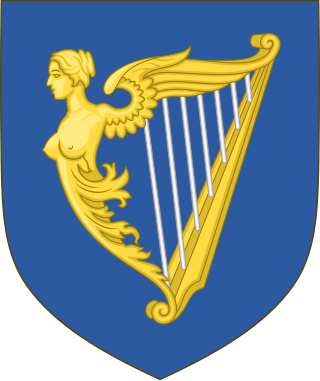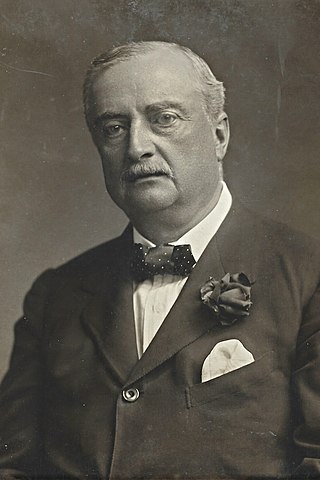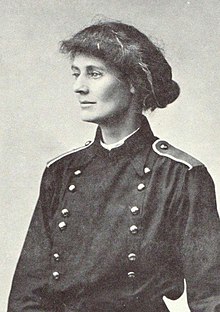The Second Dáil was Dáil Éireann as it convened from 16 August 1921 until 8 June 1922. From 1919 to 1922, Dáil Éireann was the revolutionary parliament of the self-proclaimed Irish Republic. The Second Dáil consisted of members elected at the 1921 elections, but with only members of Sinn Féin taking their seats. On 7 January 1922, it ratified the Anglo-Irish Treaty by 64 votes to 57 which ended the War of Independence and led to the establishment of the Irish Free State on 6 December 1922.
The First Dáil was Dáil Éireann as it convened from 1919 to 1921. It was the first meeting of the unicameral parliament of the revolutionary Irish Republic. In the December 1918 election to the Parliament of the United Kingdom, the Irish republican party Sinn Féin won a landslide victory in Ireland. In line with their manifesto, its MPs refused to take their seats, and on 21 January 1919 they founded a separate parliament in Dublin called Dáil Éireann. They declared Irish independence, ratifying the Proclamation of the Irish Republic that had been issued in the 1916 Easter Rising, and adopted a provisional constitution.

The Irish Parliamentary Party was formed in 1874 by Isaac Butt, the leader of the Nationalist Party, replacing the Home Rule League, as official parliamentary party for Irish nationalist Members of Parliament (MPs) elected to the House of Commons at Westminster within the United Kingdom of Great Britain and Ireland up until 1918. Its central objectives were legislative independence for Ireland and land reform. Its constitutional movement was instrumental in laying the groundwork for Irish self-government through three Irish Home Rule bills.

The 1918 United Kingdom general election was called immediately after the Armistice with Germany which ended the First World War, and was held on Saturday, 14 December 1918. The governing coalition, under Prime Minister David Lloyd George, sent letters of endorsement to candidates who supported the coalition government. These were nicknamed "Coalition Coupons", and led to the election being known as the "coupon election". The result was a massive landslide in favour of the coalition, comprising primarily the Conservatives and Coalition Liberals, with massive losses for Liberals who were not endorsed. Nearly all the Liberal MPs without coupons were defeated, including party leader H. H. Asquith.

East Antrim is a parliamentary constituency in the United Kingdom House of Commons. The current MP is Sammy Wilson of the DUP.

South Down is a parliamentary constituency in the United Kingdom House of Commons. The current MP for the constituency is Chris Hazzard of Sinn Féin.

North Down is a parliamentary constituency in the United Kingdom House of Commons. The current MP is Stephen Farry of the Alliance Party. Farry was elected to the position in the 2019 general election, replacing the incumbent Sylvia Hermon. Hermon had held the position since being elected to it in the 2001 general election, but chose not to contest in 2019.
The 1921 Irish elections took place in Ireland on 24 May 1921 to elect members of the House of Commons of Northern Ireland and the House of Commons of Southern Ireland. These legislatures had been established by the Government of Ireland Act 1920, which granted Home Rule to a partitioned Ireland within the United Kingdom.

The members of the First Dáil, known as Teachtaí Dála (TDs), were the 101 Members of Parliament (MPs) returned from constituencies in Ireland at the 1918 United Kingdom general election. In its first general election, Sinn Féin won 73 seats and viewed the result as a mandate for independence; in accordance with its declared policy of abstentionism, its 69 MPs refused to attend the British House of Commons in Westminster, and established a revolutionary parliament known as Dáil Éireann. The other Irish MPs — 26 unionists and six from the Irish Parliamentary Party (IPP) — sat at Westminster and for the most part ignored the invitation to attend the Dáil. Thomas Harbison, IPP MP for North East Tyrone, did acknowledge the invitation, but "stated he should decline for obvious reasons". The Dáil met for the first time on 21 January 1919 in Mansion House in Dublin. Only 27 members attended; most of the other Sinn Féin TDs were imprisoned by the British authorities, or in hiding under threat of arrest. All 101 MPs were considered TDs, and their names were called out on the roll of membership, though there was some laughter when Irish Unionist Alliance leader Edward Carson was described as as láthair ("absent"). The database of members of the Oireachtas includes for the First Dáil only those elected for Sinn Féin.
There were two elections in Ireland on 24 May 1921, following the establishment of the House of Commons of Northern Ireland and the House of Commons of Southern Ireland under the Government of Ireland Act 1920. New constituencies were established for both parliaments. A resolution of Dáil Éireann on 10 May 1921 held that these elections were to be regarded as elections to Dáil Éireann and that all those returned at these elections be regarded as members of Dáil Éireann. According to this theory of Irish republicanism, these elections provided the membership of the Second Dáil. The Second Dáil lasted 297 days.
Abstentionism is the political practice of standing for election to a deliberative assembly while refusing to take up any seats won or otherwise participate in the assembly's business. Abstentionism differs from an election boycott in that abstentionists participate in the election itself. Abstentionism has been used by Irish republican political movements in the United Kingdom and Ireland since the early 19th century. It was also used by Hungarian and Czech nationalists in the Austrian Imperial Council in the 1860s.
Sinn Féin is the name of an Irish political party founded in 1905 by Arthur Griffith. It became a focus for various forms of Irish nationalism, especially Irish republicanism. After the Easter Rising in 1916, it grew in membership, with a reorganisation at its Ard Fheis in 1917. Its split in 1922 in response to the Anglo-Irish Treaty which led to the Irish Civil War and saw the origins of Fianna Fáil and Fine Gael, the two parties which have since dominated Irish politics. Another split in the remaining Sinn Féin organisation in the early years of the Troubles in 1970 led to the Sinn Féin of today, which is a republican, left-wing nationalist and secular party.
Thomas James Mitchell was an Irish republican. He was active in the Irish Republican Army and took part in a raid on Omagh barracks in 1954, being captured and imprisoned. While in jail he was twice elected as a Member of the United Kingdom Parliament, but was disqualified and his elections overturned.
North Kilkenny was a parliamentary constituency in Ireland, represented in the House of Commons of the Parliament of the United Kingdom. It returned one Member of Parliament (MP) from 1885 to 1922.
South Dublin, a division of County Dublin, was a county constituency in Ireland from 1885 to 1922. It elected one Member of Parliament (MP) to the House of Commons of the Parliament of the United Kingdom, using the first past the post voting system.
South Fermanagh was a UK Parliament constituency in Ireland.
St Anne's, a division of Belfast, was a UK parliamentary constituency in Ireland. It returned one Member of Parliament (MP) to the House of Commons of the United Kingdom from 1918 to 1922, using the first past the post electoral system.
Victoria, a division of Belfast, was a UK parliamentary constituency in Ireland. It returned one Member of Parliament (MP) to the House of Commons of the United Kingdom from 1918 to 1922, using the first past the post electoral system.
The Anglo-Irish Treaty was signed in London on 6 December 1921 and Dáil Éireann voted to approve the treaty on 7 January 1922, following a debate through late December 1921 and into January 1922. The vote was 64 in favour, 57 against, with the Ceann Comhairle and 3 others not voting. The Sinn Féin party split into opposing sides in the aftermath of the Treaty vote, which led to the Irish Civil War from June 1922 to May 1923.

The Irish component of the December 1910 United Kingdom general election took place between 3 and 19 December, concurrently with the polls in Great Britain. Though the national result was a deadlock between the Conservatives and the Liberals, the result in Ireland was, as was the trend by now, a large victory for the Irish Parliamentary Party. The IPP supported the Liberals to form a government after the election. This was to be the party's last victory, however. Due to the outbreak of World War I in 1914, the next general election would not be held until 1918, by which time events both in Ireland and Britain and outside would conspire to see the rise of a new nationalist party, Sinn Féin, and the subsequent demise of the IPP.














